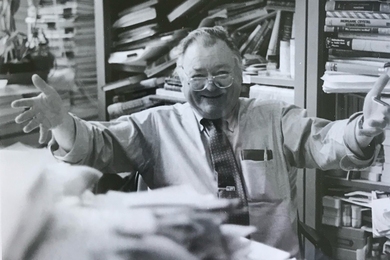What science and technology can't control-a rainswept day-rudely intruded on MIT's planned outdoor commencement program Monday (June 1), but couldn't seriously dampen the singular joy of graduation for 1,705 graduates and their families.
For the first time in 13 years, since graduation exercises were moved outside to Killian Court in 1979 to accommodate more guests, a steady rain forced the formal program back to Rockwell Cage, which had been prepared in advance for just such an eventuality.
While this separated the graduates from their families and guests, numbering about 8,000, until it was time to hand out diplomas, most appeared to accept the disappointment in stride. As one observer commented, what was lost in pomp and circumstance may have been made up in intimacy because of the closer surroundings of the three locations-the Johnson Athletics Center, Kresge Auditorium and duPont Gymnasium, all filled to capacity-where the graduates received their degrees following the speaking program.
Most of the guests waited for the graduates at the three sites, where they heard a broadcast of the ceremonies, while some watched the program on closed-circuit television at several campus locations.
President Charles M. Vest, who gave out bachelor of science degrees at the Johnson Center (to all, he joked, except for those majoring in atmospheric science), told the audience that, from all he could see, graduation under "Plan B" continued to be "a warm and wonderful occasion."
As the graduates received their degrees, with their names read individually according to tradition, there were the usual yelps and shouts from the audience and from a few of the graduates, a couple of whom celebrated with exuberant leaps off the stage.
But the loudest moment of all occurred during the formal program in Rockwell Cage when President Vest asked the graduates to show their appreciation to their families and friends even though they were separated by "brick walls." The graduates responded with prolonged applause, shouts, whistles and foot-stomping that President Vest said would have conveyed their message even in the absence of a sound system.
Because some students received more than one degree, the total number of degrees-1,894-exceeded the number of students receiving them. Altogether, 898 bachelor of science degrees and 996 advanced degrees were awarded. The advanced degrees included 228 doctorates, 749 master of science degrees and 19 engineer degrees.
The degree recipients included 489 women, of whom 315 received bachelor of science degrees.
In his prepared commencement speech (see text, Pg ), US Representative Les Aspin (D-Wis.), chairman of the House Armed Services Committee and a key member of Congress in shaping national defense policy, said that new nuclear policies-supplanting the nation's traditional reliance on deterrence-will be needed in the post-Cold War era to deal with the threat of nuclear proliferation.
As examples, he suggested a comprehensive test ban treaty, a limited ground-based defense against incoming missiles and the possibility of preemptive strikes. (The latter was dropped from the delivered speech, in order to shorten the talk, but the Congressman's office said the prepared speech gave his full views.)
Rep. Aspin, who received a PhD in economics from MIT in 1966, told the graduates they were inheriting a world in which the threat of a superpower nuclear exchange "has receded to the vanishing point," but in which the threat of nuclear detonations "by smaller nations or even by subnational or terrorist groups" will increase.
As one step toward winning international cooperation against the proliferation of nuclear weapons, he said, the United States should stop nuclear testing.
"In the days when we relied on nuclear weapons as the equalizer versus Soviet conventional forces, it was necessary to conduct nuclear weapons tests primarily for modernization," he said. "But no more. That means there is no compelling reason to do it."
As for new defenses, he said they would have to include measures to guard against delivery systems other than missiles, such as "air and sea-borne threats and suitcase bombs." He said it will mean putting more effort "into our technology for the detection of nuclear weapons by our customs officers and coastal defense."
Finally, he said the nation also will have to decide whether its post-Cold War nuclear policy should include "pre-emption"-using force as "the only way in some instances to stop the use of nuclear weapons" by leaders like Iraq's Saddam Hussein.
Following Rep. Aspin's address, Furio Ciacci, president of the Graduate Student Council, delivered a salute to MIT from the graduate student body. Aileen W. Lee, president of the Class of 1992, then presented the senior gift to President Vest, $10,060.48 (which included matching funds from the 50-year Class of 1942) as start-up funds for a program to encourage disadvantaged junior high school students to pursue science and technological education and careers. (MIT Tech Talk, May 27).
In his traditional charge to the graduates (see text, Pg ) President Vest told them they could set no greater goal for themselves "than that of restoring some modicum of tolerance and civility in this country and this world."
"How strange it is," he said, "that just as the world revolts against communism and moves toward democracy. . . we begin to fragment along almost every conceivable fault line in our society."
As a result, he said, "we are losing the great goals of this nation of immigrants, of a society built to be an amalgamation of cultures and races that is greater than the sum of its parts."
"We are far from that goal," he said. "Indeed, we seem to be in the midst of what Arthur Schlesinger calls the `disuniting of America.' You must help to stem the centrifugal forces that would pull us apart. We need tolerance, not divisiveness; mutual respect, not disdain; love, not hate; civility, not revenge; hard work, not empty rhetoric; excellence, not mediocrity; grand strategies, not just tactics."
Those awarding advanced degrees were the deans of MIT's five schools, John de Monchaux of the School of Architecture and Planning (duPont), Joel Moses of the School of Engineering (duPont), Philip S. Khoury of the School of Humanities and Social Science (Kresge), Lester C. Thurow of the School of Management ( Kresge) and Robert J. Birgeneau of the School of Science (Kresge). Graduates receiving doctorates had been hooded in a special ceremony on Sunday (May 31).
The formal activities began at 9:45am with the traditional academic procession into Rockwell Cage, led by the chief marshal, Peter M. Saint Germain, a 1948 MIT graduate, a member of the MIT Corporation and 1991-92 president of the Association of MIT Alumni and Alumnae.
Other principals in the line of march included Dr. Paul E. Gray, chairman of the Corporation, who presided at the ceremonies; David S. Saxon, honorary chairman of the Corporation; Provost Mark S. Wrighton, J. Kim Vandiver, chairman of the faculty; Cambridge Mayor Kenneth E. Reeves, and Swami Sarvagatananda of the Ramakrishna Vedanta Society of Boston, an MIT chaplain, who gave the invocation (See Pg. ).
Professor Ellen T. Harris, associate provost for the arts, led the audience in the singing of the National Anthem and, at the end of the program, in the school song, "In Praise of MIT."
The Brass Ensemble, a student group led by Herbert Philpott, joined the Boston Brass Ensemble, conducted by John D. Corley Jr., provided the music in Rockwell Cage.
Following the exercises, President Vest held a reception for graduates and their families-and for alumni/ae both of the 50th reunion Class of 1942 and the 25th reunion Class of 1967-in the Johnson Athletics Center. The Intermission Trio Plus, led by Associate Provost S. Jay Keyser, provided the music at the reception.
Professor Martin F. Schlecht, chairman of the Commencement Committee, and Mary L. Morrissey, director of the Information Center and special events and executive officer for commencement, planned the commencement program, including the alternate arrangements.
In the morning, prior to commencement, the MIT Corporation elected two life members and nine term members at its quarterly meeting (see Pg. ).
In the afternoon, graduating cadets and midshipmen in MIT's Army, Air Force and Navy Reserve Officers Training Corps (ROTC) units received their military commissions in a ceremony at the Charlestown Naval Historical Park, where the historic frigate USS Constitution is berthed. The speaker was Marine Corps Col. Kenneth D. Cameron, an astronaut and 1987 MIT graduate.
A version of this article appeared in the June 3, 1992 issue of MIT Tech Talk (Volume 36, Number 33).





